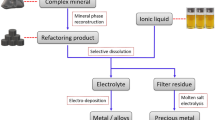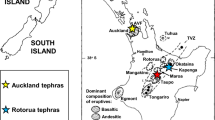It is established that the argillaceous part zircon-ilmenite ore gravitation tailings (ZIG) is a refractory clay, but it has a complex mineral composition, including in contrast to traditional refractory clays more than ten minerals and an increased amount of Fe2O3 (>5%). The main clay mineral of ZIG is kaolinite, which is poorly crystallized. An increase in ZIG ceramic specimen firing temperature to 1300°C promotes pore size uniformity.








Similar content being viewed by others
References
E. S. Abdrakhimova, “Structure formation of acid-resistant refractories with firing of the argillaceous part zircon-ilmenite ore gravitation tailings,” Refractories and Industrial Ceramics, 50, No. 5, 234 – 237 (2009).
E. S. Abdrakhimova, “Effect of pyrophillite on the drying properties of acid-resistant refractories based on the argillaceous part zircon-ilmenite ore gravitation tailings, Refractories and Industrial Ceramics, 50, No. 6, 409 – 411 (2009).
E. S. Abdrakhimova and V. Z. Abdrakhimov, “Processes that occur during firing of the argillaceous part zircon-ilmenite ore gravitation tailings,” Refractories and Industrial Ceramics, 50, No. 2, 101 – 106 (2009).
E. S. Abdrakhimova, “Effect of pyrophyllite on the mechanical properties and acid resistance of acid-proof materials,” Refractories and Industrial Ceramics, 50, No. 3, 174 – 177 (2009).
E. S. Abdrakhimova, “Effect of feldspar concentrate on the chemical resistance of acid-resistant materials prepared on the basis of different chemical and mineral compositions,” Refractories and Industrial Ceramics, 49, No. 6, 422 – 425 (2008).
E. S. Abdrakhimova, “Effect of feldspar concentrate on processes that occur during firing of acid-resistant materials based on nonferrous metallurgy concentration waste materials and pyrophillite,” Refractories and Industrial Ceramics, 49, No. 5, 336 – 339 (2008).
V. Z. Abdrakhimov, “Ecological and practical aspect of the use of high-alumina petrochemical waste products in the manufacture of acid-resistant materials,” Refractories and Industrial Ceramics, 51, No. 1, 52 – 55 (2010).
V. Z. Abdrakhimov, “Ecological and practical aspects of the use of salt aluminum slags in the productions of ceramic acid-resistant materials,” Refractories and Industrial Ceramics, 51, No. 2, 121 – 125 (2010).
E. S. Abdrakhimova and V. Z. Abdrakhimov, Acid-Resistant refractory Objects with Use of Nonferrous Metallurgy Wastes and Nontraditional Material of Western Kazakhstan [in Russian], Novosibirsk State Architectural Building Univ., Novosibirsk (2000).
E. S. Abdrakhimova, I. V. Kovkov, D. Yu. Denisov, et al., Physicochemical processes During Firing of Argillaceous Materials of Different Chemical and Mineral Composition [in Russian], Perspective Development Center, Samara (2008).
V. Z. Abdrakhimov and E. S. Abdrakhimova, Physicochemical Processes of Structure Formation in Ceramic Materials Based on Nonferrous Metallurgy and Power Generation Wastes [in Russian], West Kazakhstan State Technical University, Ust’-Kamenogorsk (2000).
V. Z. Abdrakhimov, Production of ceramic Objects Based on Power Generation and Nonferrous Metallurgy Wastes [in Russian], West Kazakhstan State Technical University, Ust’-Kamenogorsk (1997).
E. S. Abdrakhimova and V. Z. Abdrakhimov, “Features of phase transformation during firing of nonferrous metallurgy waste,” Materialovedenie, No. 11, 51 – 56 (2001).
E. S. Abdrakhimova and V. Z. Abdrakhimov, Physicochemical Processes During Firing of Acid-Resistant Refractories [in Russian], Nedra, St. Petersburg (2003).
V. Z. Abdrakhimov and E. S. Abdrakhimova, Chemical Technology of Ceramic Brick Using Technogenic Raw Material [in Russian], West Kazakhstan State Technical University, Ust’-Kamenogorsk (2007).
E. S. Abdrakhimova, A. V. Abdrakhimov, and V. Z. Abdrakhimov, “Features of structural transformations of iron compounds in argillaceous materials of different chemical and mineralogical composition,” Materialovedenie, No. 12, 43 – 46 (2002).
E. S. Abdrakhimova and V. Z. Abdrakhimov, “Structural transformations of iron compounds in argillaceous materials according to Mossbauer spectroscopy data,” Zh. Fiz. Khim., 80, No. 7, 1227 – 1232 (2006).
E. S. Abdrakhimova and V. Z. Abdrakhimov, “Synthesis of mullite from technogenic raw material and pyrophyllite,” Zh. Neorg. Khim., 52, No. 3, 395 – 400 (2007).
V. Z. Abdrakhimov, “Role of iron oxide in forming the structure of ceramic mineral materials,” Izv. Vyssh. Uchebn. Zaved., Stroitel’stvo, No. 2, 31 – 37 (2009).
V. Z. Abdrakhimov, Study of Iron-Containing Traditional Natural and Technogenic Raw Materials on Caking of Ceramic Materials, Effect of Fe 2+ and Fe 3+ Ions on Forming Low-Temperature Mullite [in Russian],West Kazakhstan State Technical University, Ust’-Kamenogorsk (2009).
A. I. Avgustinik, Ceramics [in Russian], Lenizdat, Leningrad (1975).
A. I. Miklashevskii, Artiastic Ceramic Technology [in Russian], Izd. Lit. po Stroitel’stvu, Leningrad (1972).
G. V. Kukolev, Silica Chemistry and Silicate Physical Chemistry [in Russian], Vyssh. Shkola, Moscow (1965).
V. F. Pavlov, Physicochemical Bases of Firing Objects of Structural Ceramics [in Russian], Stroizdat, Moscow (1977).
P. P. Budnikov, V. L. Balkevich, A. S. Bereznoi, et al., Chemical Technology of Ceramics and Refractories [in Russian], Stroiizdat, Moscow (1972).
V. Z. Abdrakhimov, M. P. Zelig, E. S. Abdrakhimova, et al., “Correlation of porous-capillary structure and frost resistance of ceramic material,” Materialovedenie, No. 6, 19 – 23 (2005).
E. S. Abdrakhimova and V. Z. Abdrakhimov, Bases of Technical Ceramics [in Russian], West Kazakhstan State Technical University, Ust’-Kamenogorsk (2001).
V. Z. Abdrakhimov, I. A. Togzhanov, S. Zh. Saibutalov, et al., “Study of the pre structure in ceramic material,” Izv. Vyssh. Uchebn. Zaved., Stroitel’stvo, No. 6, 72 – 75 (1988).
A. Guinier, x-ray Crystals [Russian translation], Fizmatgiz, Moscow (1961).
Author information
Authors and Affiliations
Additional information
Translated from Novye Ogneupory, No. 1, pp. 10 – 16, January 2011.
Rights and permissions
About this article
Cite this article
Abdrakhimova, E.S., Abdrakhimov, V.Z. Physicochemical methods for studying the mineral composition and pore structure for the argillaceous part zircon-ilmenite ore gravitation tailings. Refract Ind Ceram 52, 1–5 (2011). https://doi.org/10.1007/s11148-011-9352-7
Received:
Published:
Issue Date:
DOI: https://doi.org/10.1007/s11148-011-9352-7




